Now, at first. This it totally unsupported by VMware or Dell, even if the firmware I'm flashing the card with is from Dell's website. To tell you the whole story you should read My VSAN Journey and understand how the setup in my lab is built and why I'm doing this. I'm basically trying to run a VSAN cluster on totally unsupported hardware (like a lots of folks with homelabs). The only component I used to have my VSAN working was the famous Dell Perc H310. BUT this storage controller which at origin was on the HCL was recently pulled out by VMware because of its low queue depth. How-to Flash Dell Perc H310 with IT Firmware is today's post which will walks you through the firmware upgrade (or rather wipe first > upgrade second).
The thing is that the Dell Perc H310 in reality is an LSI card (after firmware flash the card reveals it's real name…) – LSI SAS 2008 (B2) which has a 6Gbs throughput. The firmware used is Dell's firmware. With the help of few posts on forums from folks that did the same thing I successfully changed my adapter's queue depth from 25 to 600 by applying this new firmware !!! The H310 cards can be found on eBay for cheap and it's no wonder that it's quite popular among homelab users using ZFS builds based on OpenSolaris or Linux. After applying the IT Firmware My homebrewed VSAN cluster has not only 10GbE (via Infiniband) but also large queue depth which was a bottleneck during rebuilds and resync operations…
Before and after, checking the queue depth of the card…
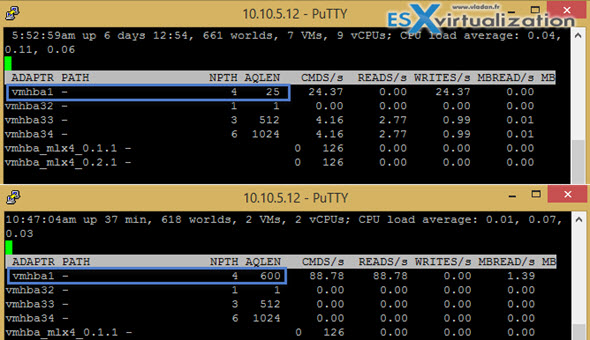
IT Firmware – What's that?
There are IR firmware and IT firmware. The difference is that IR firmware can do RAIDs and IT firmware can't, but has greater performance. it's best for use for storage platforms OpenSolaris, Linux, or Windows Home Server to manage software RAID and redundancy.
VMware vSphere 5.5 did recognized the card as Dell's card (after the flash). Here is a shot before and after….

Do at your own risk
Here are the steps I used.
01. Prepare an USB drive you can boot into DOS (use Rufus, easy one)
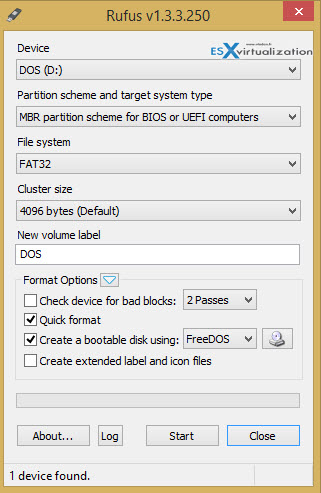
Create a folder. I called mine Dell. Then I went to Dell's website to get the firmware. I took the one for SAS 6GbS….
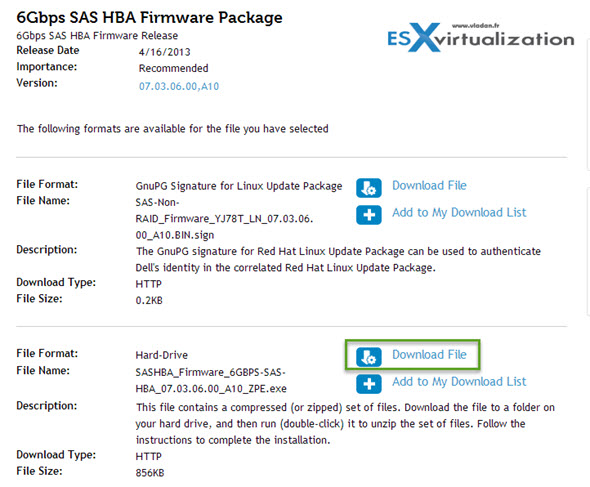
The firmware file is called 6gbpsas.fw
In reality, there is another zip package (with the exactly original firmware inside) and which has all the necessary tools in it (including the exact firmware file – the 6gbpsas.fw. The package can be downloaded from this link on mediafire: LSI-9211-8i.zip tools (link).
02. Wipe the card completely otherwise sas2flsh do not recognize it as an LSI card (so the sas2flsh commands don't work). One must use megarec command to do the work. This command wipes all except the hardware SAS address unique for each card (which is good as you don't have to save it first to add it back later)
Updated the above statement as one of our readers reported that wasn't correct.
So, I did:
megarec -writesbr 0 sbrempty.bin
megarec -cleanflash 0
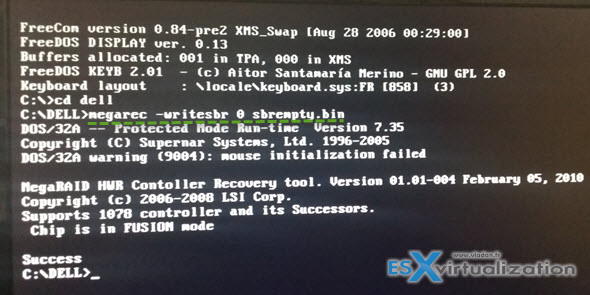
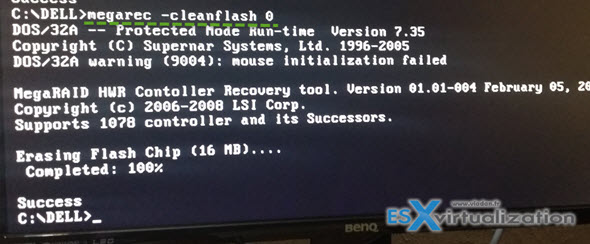
03. At this time – reboot the host and boot back via the USB into DOS.
04. After reboot, back to DOS. Enter this command:
sas2flsh -o -f 6gbpsas.fw
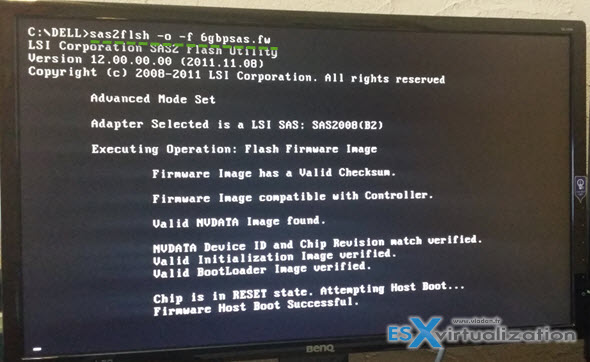
Takes few minutes…
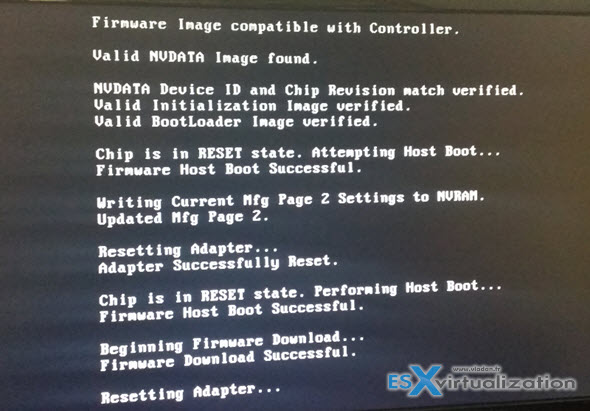
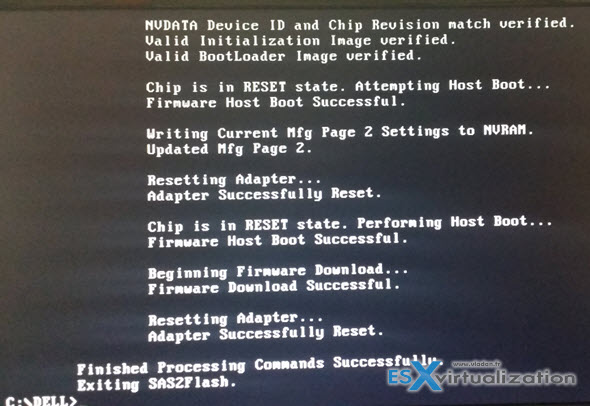
05. (Optional) If you want to put the BIOS back in place you can, but you don't have to if you're using the card just for the passthrough. During the boot you won't be able to hit CTRL + C and dig into details, but that's all.
So If you want to put the bios back in place, so at boot so you could hit Ctrl-C and check out the HBA bios then you would go with this command from DOS window to add the BIOS back:
sas2flsh -o -b mptsas2.rom
for EFI based boards you'd use this:
sas2flash.efi -o -b x64sas2.rom
But in my case I did not. In reality, two of my ESXi builds do have BIOS and only one is UEFI based board. After few attempts with the UEFI based board, which is my ESXi Haswell box, I did not want to lose time so I simply unplugged the card from the newer mobo and plugged it into the older board just for the 2-3 min of the flashing process…
You might do the same if you have an older board available. In case you have only a newer board you'll have to seek the solution to boot into a UEFI to flash from within there as the DOS based environment just throws an error when executing the command megarec -writesbr 0 sbrempty.bin
Wrap Up:
Pretty glad it worked for me and I managed to upgrade my cards which should get more performance and throughput for my homebrewed VSAN installation… -:)
As being said at the beginning, do at your own risk. There is no official support for it from VMware or Dell. But with few precautions and with few hours of documentation through blogs and forums, it's quite easy at the end. The H310 are quite cheap on eBay and some of those guides are also flashing H200 cards as well which is a card with the same LSI 2008 hardware chip apparently.
Sources:
https://forums.overclockers.com.au/showthread.php?t=1045376
https://techmattr.wordpress.com/2013/08/30/sas-hba-crossflashing-or-flashing-to-it-mode/
Update: I have had one host which was taking a good 5 min to pass the boot sequence for the sas2flash when booting ESXi 6.0. So I followed this guide here from Dan Richardson to flash the card to the latest release 20 … but there were problems…
There is nothing wrong with this guide, but it basically flashes the IR firmware, not the IT firmware. When I wanted to use the IT firmware, I have had a message saying that I cannot flash IT firmware over IR firmware. But what the hell I thougt. The firmware I had was an IT firmware! I double checked during the boot… strange situation…
Oh well, what I done is that I erased the card again. The problem was that after full wipe with the commands at the beginning of the post:
megarec -writesbr 0 sbrempty.bin
megarec -cleanflash 0
I got an error message saying that “Firmware Host Boot Unsuccessful” and then the program has exited when I attempted to upgrade the firmware….
I thought, what next?
Then after erasing and trying different things again I have done this via UEFI and brought here another error:
fs0:> sas2flash.efi -o -f 2118it.BIN
LSI Corporation SAS2 Flash Utility
Version 19.00.00.00 (2014.03.17)
<copyright>
Advanced Mode SetAdapter Selected is a LSI SAS: SAS2008(B2)Executing Operation: Flash Firmware Image:
Firmware Image has a Valid Checksum.
Firmware Version 19.00.00.00
Firmware Image compatible with Controller.Valid NVDATA Image found.
NVDATA Version 11.00.00.00
Checking for compatible NVData image…NVData Device ID and Chip Revision match verified.
Valid Initialisation Image verified.
Valid Bootloader Image verified.Chip is in RESET state. Attempting Host Boot…
Firmware Host Boot Successful.Mfg Page 2 Mismatch Detected.
Writing Current Mfg Page 2 Settings to NVRAM.
Failed to Validate Mfg Page 2!Due to error remaining commands will not be executed.
Unable to Process Commands.
Existing SAS2Flash.
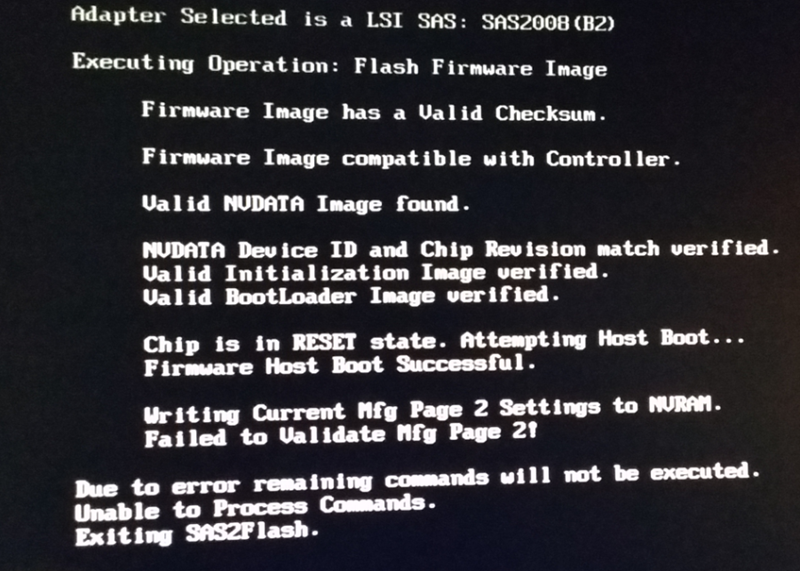
Helpfull resource:
https://www.supermicro.com/support/faqs/faq.cfm?faq=13612
and also helpful LDI page:
https://mycusthelp.info/LSI/_cs/AnswerDetail.aspx?inc=8352
guided me to do the re-flash with the megarec command instead and flash the older Dell firmware (the 6gbpsas.FW) . That's what I have done to be able to recover the card in state where it could be flashed to the newest IR firmware. (not IT firmware)
The error in DOS was this one:
ERROR: failed to initialize PAL Exiting.
through the EFI at the end I end up with this:
sas2flsh -o -f 2118ir.bin
and I'm done.
To recap:
1. erase the card with
megarec -writesbr 0 sbrempty.bin
megarec -cleanflash 0
2. reboot
3. boot to efi and change to your USB via
fs0:
4. execute this command to flash the firmware and bios (this is the IT firmware I originally used in this post)
sas2flash.efi -o -f 6gbpsas.fw -b mptsas2.rom
5. reboot
6. repeat step 3 and flash the latest (version 20) IR firmware and bios
sas2flash.efi -o -f 2118ir.bin -b mptsas2.rom
You're done. The IR firmware has also queue depth 600 so in case you want to use it with VSAN it's good candidate. It's IR firmware however…
The boot time is back to normal and I have disabled the card via ctrl+c at bios prompt as I'm not booting on any of those disks.

Enjoy…

Hi Vladan,
When I wiped the firmware and rebooted host, it comes up saying “Invalid PCIe card found in the Internal Storage slot System halted!” and just hangs there.
I guess this is due to the SAS card not detected as it does not have any config on this?
Do you have any suggestion on fixing this?
Thanks,
RCK
Ha. That’s odd. Haven’t had that issue at all. Pretty sure my steps has worked as I’ve done those 3 times (I have 3 Perc 310 cards).
You should be able to boot into the DOS via your USB stick, right? The DOS prompt should be first. If you can pass that and boot into the USB then you should be able to flash with the new SAS firmware …..”sas2flsh -o -e 6gbpsas.fw”
When the original firmware got wiped and host got rebooted (R720), it didn’t even get to the memory/idrac test stage. It basically error’ed out in 10 seconds, and server halted.
I’m going to order another H310 from ebay for a test, would you think it would be worth trying to flash new firmware after the erase, without reboot?
If you have doubts, just check around the different forums and blogs (there is quite a few). Most of them are much of the same like what I did and documented here.
I guess it’s just bad luck, or card problem. Check this link where there is tons of screenshot from the process too…. http://forums.overclockers.com.au/showthread.php?t=1045376
If you find a problem don’t hesitate to say what was wrong (card, slot, server, procedure, the technician… -:)… We’re all here to share.
Best luck.
There are a few other OEM LSI SAS2008 models out there including the IBM M1015 and the Intel SASUC8I which you can use the same BIOS.
What appears to be a mostly complete list can be found here including motherboards that have it embedded:
http://forums.servethehome.com/index.php?threads/lsi-raid-controller-and-hba-complete-listing-plus-oem-models.599/
(The list isn’t complete since it’s missing at least the Sun SGX-SAS6-INT-Z, but it’s usually way overpriced if you are just getting it for a home lab)
I have a production Dell T420 with the PERC H310. Can I run this firmware update without losing my RAID settings etc?
Or is there anyway to force the H310 to use the cache of the physical disks? Atleast, that might improve performance.
Thank you for any advise.
If you flash it with IT firmware, there is no more RAID. So don’t do it if you want to keep RAID as I flashed it only towards the possibility to pass through my disks directly to the ESXi hypervisor. Now it’s my VSAN which do the magic and protects the whole cluster against failure.
Ah yes. I meant the IR firmware referenced in the article which has RAID support. Thanks!
Fahd, did you have success with flashing the R420’s H310 controller? I too have a similar R420 server and I’m curious if it will work or not.
I also want to know if it is possible to preserve the original RAID firmware that came with the PERC H310 in case things go sideways with the ability to restore.
Not tested with R420 cause I don’t have that one in stocks. The original firmware shall be available on the manufacturer’s website… but again, haven’t tested that once flashed with the IT firmware… -:).
It is not:
sas2flsh -o -e 6gbpsas.fw
But:
sas2flsh -o -f 6gbpsas.fw
Glad you took a picture!
Thanks… -:) I updated the post. Yes, the screenshot is right…
Thankyou! I ordered my second perc h310 and use it for zfs!
Flashed my second Perc H310 with success!! Tomorrow i will place both cards in my system, hope i can get 12 hdd’s attached! 😉
Hello, has any one tried this with the H330 HBA?
Hi, a small word of caution: If you try and flash a H310 Mini adaptor (like the one in a PowerEdge R320) to the IT firmware, you will effectively brink your storage.
After performing the wipes in the beginning with megarec, sas2flsh still did not recognise the controller, but so far so good (or so I thought).
After rebooting the server it stalled on an invalid controller in the internal storage slot and just said “System halted” and never completed POST.
I’ve had to RMA the controller to get access to my disks again..
I wish I saw this earlier… I’m out of warranty…
Did the same on my R320 as well. Another forum mentioned they are PCI ID locked for the H310 mini with Dell IR firmware.
Have 2 cards that are ready to have new FW flashed, but my systems wont boot with them in, and if I plug in after, do not detect so I cannot flash them back to IR…
I know this is a very late reply, but there’s a good youtube video detailing recovery of an H310 mini using a $15 usb eprom programmer: https://www.youtube.com/watch?v=koyVehVIXA8
It’s now possible to flash the H310 mini to IT mode, and it may be possible to recover bricked units.
I have a problem flashing my H310. I wanted to flash it to IT mode, and i followed this guide:
https://techmattr.wordpress.com/2013/08/30/sas-hba-crossflashing-or-flashing-to-it-mode/
I did not see this guide before, just after my problem occured…
Only little problem is i have a slightly different card: http://store.flagshiptech.com/dell-poweredge-perc-h310-mini-mono-raid-controller-6gb-s-k09cj/
It is situated in my Dell Poweredge r720xd.
I’ve read a post above here about it, that a guys bricked it. So i think i did the same thing…
I started to flash and now i ran into a problem, which i can not bypass, and i hope some more experienced flashers here can help me out.
I first booted into Freedos and started the flash proces as discribed:
megacli -AdpAllInfo -aAll -page 20 (I did this and i have the adress writen down)
megarec -writesbr 0 sbrempty.bin (This command failed as discribed)
megarec -cleanflash 0 (This worked out and the card was cleared)
Reboot the system
sas2flsh -o -f 6GBPSAS.FW (this is where the problems started)
At point 5 i got an error message that the card was not recognised. I thought it would be a good idea to reboot again. Maybe something went wrong. Now when i try to boot i get the following message:
“Invalid PCIe card found in the Internal Storage slot!”
“System halted!”
http://imgur.com/EinmZJP
This message appeard before the boot options, so i am not able to boot from the usb disk again, wich makes is hard to flash :p. When i take the raid controller out, i am able to boot into the bios and/usb drive again, but i am unable to solve the flash issue because the card is out…
So it feels like i’m kinda stuck with a bricked raid controller… :/
Any ideas how to solve this? I read something about placing it in another slot, but because it’s not a default card, i am unable to place it into another slot.
I hope you guys can help me and i don’t need to buy a new controller. And if i do buy a new one i’m affraid to end up with the same situation…
Exact same issue on my R320, with same H310.
Thank you for this
I ended up using DOS for everything.
Hi!
I tried to flash my new H310 with IT firmware using this tutorial, but i failed.
“megarec -writesbr 0 sbrempty.bin” and “megarec -cleanflash 0” run successfully.
(I have to mention, that I had to reboot the server after “writesbr”. Without reboot “cleanflash” failed with this error message “Flash is not programmable”)
After reboot “sas2flsh -o -f 6gbpsas.fw” failed with error message “Firmware Download Failed!”.
I tried to flash the card in a HP DL380G7 and in a HP DL380G5 without success.
Do you have any suggestion what is wrong here?
Thank you!
I’m unable to help as the hardware was sold…
I put the card in a consumer UEFI motherboard and it worked.
Thanks anyway 🙂
My post has disappeared 🙁
it was by accident?
ohh i can see it again…
My post disappeared here, then appeared again and a few minutes it disappeared again, wierd…
The IT keeps its mystery -:)…
I was able to get the card into proper IT mode and update it all the way to the most recent P20 firmware by starting with the instructions found here:
http://lime-technology.com/forum/index.php?topic=12767.615
The zip download (http://www45.zippyshare.com/v/51016808/file.html) has everything you need to get to the P16 version of the firmware and from there I just went and grabbed the P20 version from the Avago website (http://www.avagotech.com/products/server-storage/host-bus-adapters/sas-9211-8i#downloads) and grabbed the latest firmware.
There are batch files in the zip download that automate the process, but if you edit the batch files, you can see exactly what is happening and it really does work.
PS: After this update, the card is not detected as a Dell card but an LSI card.
Can confirm this works
Make sure to follow the instruction in the __READMEFIRST.txt file
It is important to first flash the DELL firmware then the P7 (this is where you are asked y/n to flash on other hardware – answer y, its now an LSI card)
Then P16 then modify to P20 (with the Avago download 9211-8i_Package_P20_IR_IT_Firmware_BIOS_for_MSDOS_Windows) and flash P20
I flashed with BIOS, next will be trying to boot from SSD
This works without issues!! Thanks 🙂
Would such a procedure work to flash a PERC 730P to an LSI 9361-8i?
Regards,
I have issues with that the disks in my RAID doesn’t show in Vsphere 6.0U2 with Dell PERC H310. My card also show us as MegaRAID SAS SKINNY Controller, but this post got me thinking – do you see your disks in VMware, and can you detect S.M.A.R.T errors?
I can’t tell as I’m not using this card in my new lab. The 5.5 version of VSAN worked, but that was few years back.. -:)
omg, thank you so much for this guide!
I too wanted ir, and you had ir. I struggled with the same error, but the issue is you listed the error as a picture… So to save everyone headache, I’ll paste the error here so others can see it
“Due to error remaining commands will not be executed.”
Thanks for the solution in the second part of the post! Got 1.5GBs r/w speed
I’m having trouble getting the “megarec -writesbr 0 sbrempty.bin” and “megarec -cleanflash 0” to work with my perc H310. Both commands seem to lockup the system.
I get the line “Copyright (C) Supernar Systems, Ltd. 1996-2005” and a blinking cursor blow it after trying both of the commands stated above. The system remains unresponsive until I reboot. The adapter and the system performs the same after each reboot, and I’ve used various
LSI-9211-8i.zip IT mode flash packages… and all of them produce the same results.
I’m using the perc H310 adapter in a PCI-e x16 slot on my Gigabyte GA-M68MT-S2P (ver.3.0) motherboard. My system boots normally and shows the PowerEdge Bios boot screen as expected. The first command “megacli.exe -AdpAllInfo -aAll -page 20” that I sent from the dos prompt showed the adapter’s information as expected.
It’s adapter #0
Product Name: PERC H310 Adapter
Serial No: 37XXXXX
FW Package Build: 20.10.2-0002
Mfg. Data
—————–
Mfg. Date: 07/12/13
Rework Date: 07/12/13
Revision No: A00
Battery FRU: N/A
Image Versions in Flash:
—————————————-
Bios Version: 4.29.00_4.12.05.00_0x05110000
Preboot CLI Version: 03.02-015:#%00008
Ctrl-R Version: 3.00-0020
NVDATA Version: 3.09.03-0038
FW Version: 2.120.14-1504
Boot Block Version: 2.02.00.00-0001
Pending Images in Flash
—————————————
None
..
…
….
HW Configuration:
————————————–
SAS Address: 5b8cXXXXXXXXXXXX
BBU: Absent
..
…
…..
If you need any other information to assist, please advise.
Thank you for your help!
The Dell Part No. for my PERC H310 is 3P0R3. I have decided to return the card and try my luck with another PERC H310 card that has a different part no. (HV52W).
Stupid question, but how can I roll back to the original Firmware (IR)?
Haven’t tested that, but I imagine that you’ll have to download it first > flash > done… ?
Pls see
https://techmattr.wordpress.com/2014/06/13/revert-your-perc-h310-back-to-its-dell-firmware/
What is the CLI command in your putty session to show the queue depth of the card before and after? I just want to confirm what my current is 🙂
Thanks.
To clarify, unless you plan on running RAID on these H310’s, one could effectively stop once they issue this command, right?
sas2flsh -o -f 6gbpsas.fw
Since the primary intent here was VSAN, this will effectively make all disks connected passed through to ESXi as JBOD, since the controller’s BIOS wasn’t applied right?
The first part of the tutorial stopped at applying the 6gpbsas.fw, but then at the very end in the recap section, the steps keep going all the way to loading the H310’s BIOS back on.
I also have some problems after executing:
### 1. erase the card with
megarec -writesbr 0 sbrempty.bin
megarec -cleanflash 0
### I got the error below:
“Invalid PCIe card found in the Internal Storage slot!”
“System halted!”
### Next step is to:
1. remove controller
2. Set BIOS from Legacy to EUFI Boot
3. Put controller back
4. Pray to work
5. If that does not help will try to put controller on other server with EUFI boot.
Will let you know if i’m able to bring it back from the dead.
Did this work?
Hello,
Is this reflashing to make the 310 card pretty much a JBOD Sata controller. I’m looking to use it on my UnRAID NAS server.
I’ve brick a H310-mini which on DELL R620 server.
I searched all the google,but without finding any way to flash “H310-MINI,NOT general H310”,
if anyone got “H310 MINI” to run with IT firmware,please info me: [email protected]
thank you!
Hi all,
Anyone have any luck/update with the H310 mini mono? I have the R720xD and just bought the H310 Mini Mono to flash it. I didn’t read all the comments until now. 🙁
Due to physical changes in the card (compared to it’s PCIe version) – the instructions on this page WILL NOT WORK on any H310 MINI card. DO NOT run it on your Dell R720xd or else your H310 will be dead.
I got a question, i have installed my second machine with two perc h310 cards and it works with 2 TB drives. But wjat is the biggest drive i can attach with this bios flash for the perc h310
For the dutch users i made a picture-by-picture walkthrough with dutch text:
http://www.bsd05.nl/index.php/en/start-hier?showall=&start=1
Your statement “This command wipes all except the hardware SAS address unique for each card…” appears to be incorrect. I now have two cards with no SAS address and no stickers on the cards.
Oh, that’s strange as it did not happen during my tests. I corrected the post based on your experience. Sorry about that.
I did what you said (minus the BIOS boot option) and it flashed fine and I can see my Samsung 850 SSD, but for some reason I only get 3Gbps. How can I get it up to 6Gbps and the higher 600 queue depth you state? Im running CentOS 6 KVM.
[[email protected] ~]# dmesg | grep ‘Gbps’
ahci 0000:00:1f.2: AHCI 0001.0300 32 slots 6 ports 3 Gbps 0x3f impl SATA mode
[[email protected] ~]# dmesg | grep ‘scsi’
scsi0 : ahci
scsi1 : ahci
scsi2 : ahci
scsi3 : ahci
scsi4 : ahci
scsi5 : ahci
scsi6 : Fusion MPT SAS Host
scsi 6:0:0:0: Direct-Access ATA Samsung SSD 850 2B6Q PQ: 0 ANSI: 5
scsi 6:0:0:0: SATA: handle(0x000a), sas_addr(0x4433221107000000), phy(7), device_name(0x0000000000000000)
scsi 6:0:0:0: SATA: enclosure_logical_id(0x5000000080000000), slot(0)
scsi 6:0:0:0: atapi(n), ncq(y), asyn_notify(n), smart(y), fua(y), sw_preserve(y)
scsi 6:0:0:0: qdepth(32), tagged(1), simple(0), ordered(0), scsi_level(6), cmd_que(1)
mpt2sas_cm0: scsi_status(check condition)(0x02), scsi_state(autosense valid )(0x01)
sd 6:0:0:0: Attached scsi generic sg0 type 0
I’m pretty sure that the 3Gbps is the protocol limitation of SATA. Not the adapter’s limitation. Whethere for the queue depth, I did the test during the time of writing, (several years back). I’m unsure now with newer BIOS/firmware releases.
I dont think so on the protocol limitation of SATA, as when I run this command I get up to 6Gbps the HDD supports:
[root ~]# hdparm -I /dev/sda | egrep “Model|speed|Transport”
Model Number: Samsung SSD 850 EVO 2TB
Transport: Serial, ATA8-AST, SATA 1.0a, SATA II Extensions, SATA Rev 2.5, SATA Rev 2.6, SATA Rev 3.0
* Gen1 signaling speed (1.5Gb/s)
* Gen2 signaling speed (3.0Gb/s)
* Gen3 signaling speed (6.0Gb/s)
* SMART Command Transport (SCT) feature set
Hi, I tried the steps and when I use “sas2flsh -o -f 6gbpsas.fw” I get an error: failed to initialize PAL. Exiting Program.
I even tried re-erasing the board and that worked, so I still have access to the chip. It’s only that I can’t flash the IT fw. Any ideas?
Thanks in advance!
Hi, thanks so much for the guide. Ive successfully flashed the h310 to IR firmware as per guide.
However, disks are now not recognized in esxi 6.0 update 3b. It even took a long time for esxi mpt2sas module to load.
Is it because my dell t620 with the Avago bios (mptsas.rom) not communicating with 16 bay 2.5″ backplane?
The avago bios sees the drives during cold boot powerup, but during warm boot, its stuck at avago bios trying to see the drives.
I even tried to sas2flsh -o -b h310.rom and the newer dell bios FW3416A.rom but it spits an invalid header.
Hope someone can shed some light here.
If its the backplane thats causing the problem, my other option is to remove/bypass the backplane altogether and buy mini sas 8087 to 8482/ 8087 Sata cables to connect directly to the sata/sas drives.
Hi,
Can you please add 2118ir.bin also to the archive ?
regards,
Mythnick
Been running 6.0u3 without patches for a while. Then I finally updated with recent patches and have the same problem as Adam – disks aren’t recognized in ESXi. I’m just using sas-to-sata cables so not a backplane thing. Seems like a recent update broke functionality with this flashed card.
thanks for the detailed guide – do you recommend this even if you’re just using the card as JBOD for standard disk usage (just local disks in windows 10, no VSAN/VM clusters)?
Hi friends. I have some problem with ESXi 6.5 host and Dell HBA 6Gbit adapter.
My test lab: Dell R620, Perc H310 Full adapter, flashing as HBA 6Gbit P20 – IT Firmware
1TB SSD SATA 5 disk
ESXi host see only one disk, esxcli storage core device list show only boot flash and one disk.
Centos 7.5 live cd detect all 5 disks.
what do you think about it?
Hi, I’ve done this on both a H200 and a H310, but I’m wondering if you also are seeing that the firmware version is reported as 00.00.00.00 during update (i.e via Dell Update Tool / Dell update bootable ISO / idrac, etc.) and asks for an update (that don’t work). The cards itself works fine, and ESXi sees the card as a “Dell 6Gbps SAS HBA Adapter”.
tldr; does your reflashed card(s) show a firmware version of 00.00.00.00?
(I can also not see any drives in the iDrac7 – “RAC0501: There are no physical disks to be displayed. 1. Check if the host system is powered off or shutdown. 2. Check if the physical disks are inserted into the enclosure or attached to the backplane. 3. There are no out-of-band capable controllers detected.”, but I guess that could be a consequence of not being in IR mode anymore)
Thanks!
Hi, this is an old post, and as such, I no longer have this hardware in the lab. Perhaps some of our readers can reply? Thanks
To those experiencing the Dell H310 “sas2flsh -o -f 6gbpsas.fw” failed with error message “Firmware Download Failed!” issue, try flashing it on a different computer. I couldn’t get it working on HP Gen8 DL380, but was successful on another machine I had.
stuck on the pal error, I cannot seem to get into an efi shell on my consumer gigabyte board (Threadripper based) what am I doing wrong?
Being unable to overwrite the firmware from IR to IT is a known. You HAVE to use the DOS version of sas2flsh in order to do this process. If you cannot because your BIOS does not have a legacy mode like that, you’re out of luck.
This info can be found on broadcom site.
https://www.broadcom.com/support/knowledgebase/1211161501344/flashing-firmware-and-bios-on-lsi-sas-hbas